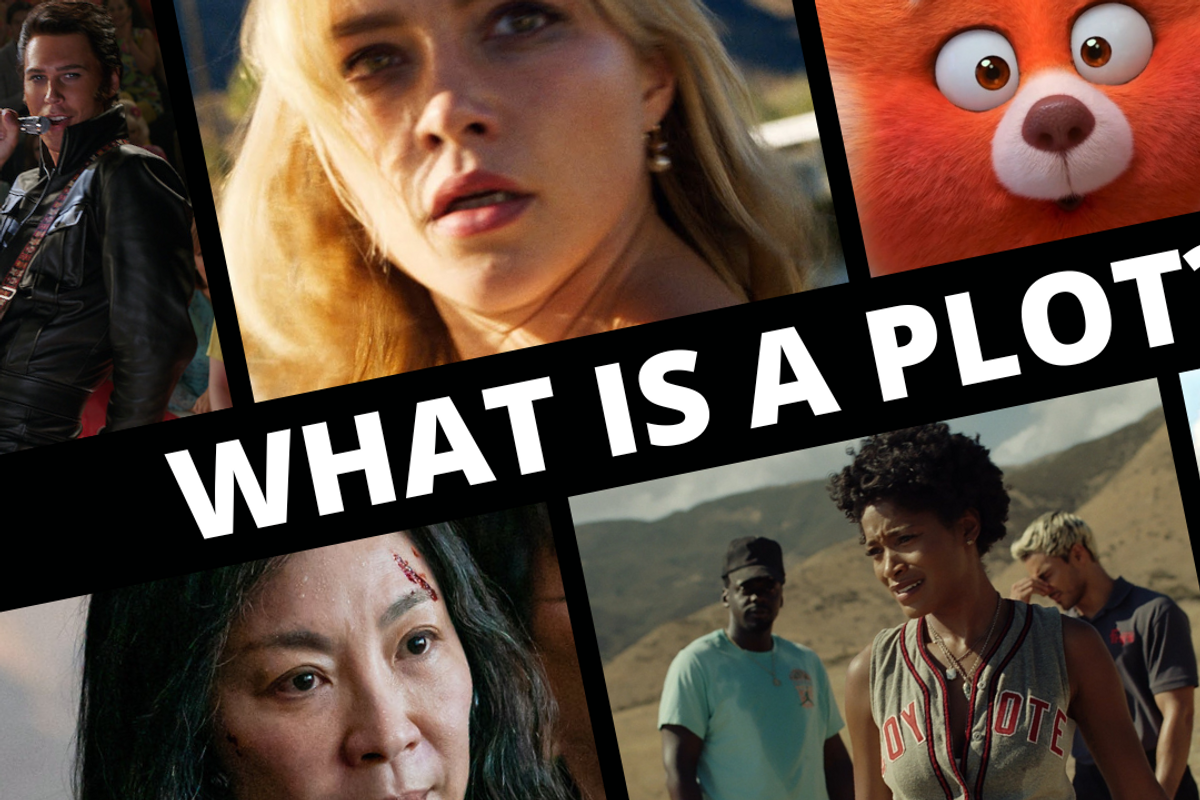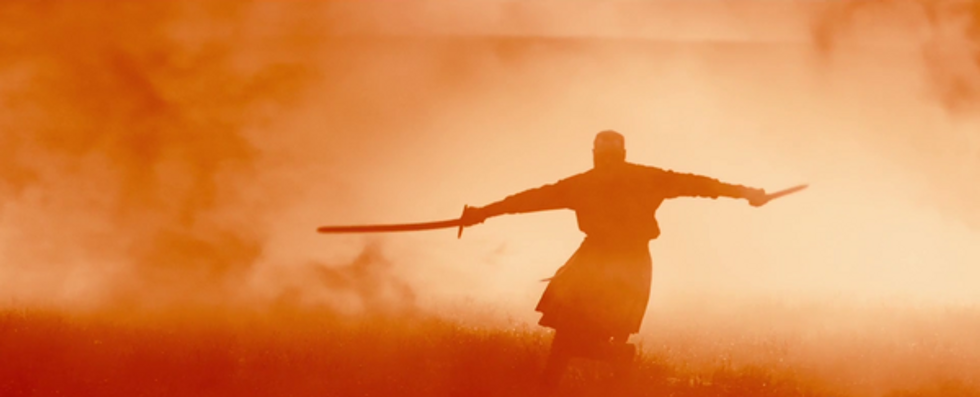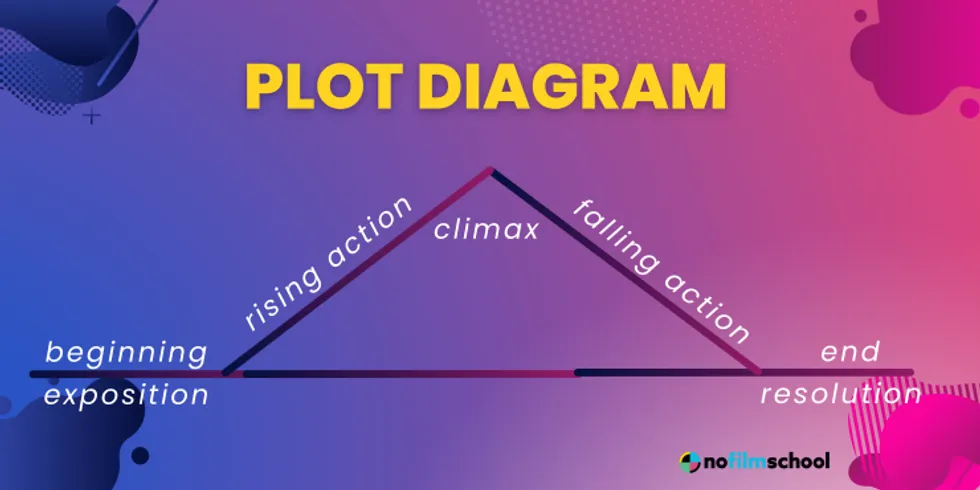
Many people think the plot of a movie or TV show is just the major events that happen. But they’re wrong. There’s a distinct story structure that sets film and TV apart from novels, short stories, and every other medium.
What I love about the plot is that you can learn it, and you can get so good at it that you won’t waste a ton of time on it later. You can get so good at writing basic plot you can also be very attractive for employment in film and TV.
So how do you get there?
Today, we’re going to go over what a plot is and is not. We’ll look at a plot diagram, check out some sequences, and chat about the events in a story. Sound good?
Let’s begin.
What Is the Plot of a Story? (Definition and Examples)

The plot is the part of a movie or TV that you think is the most important part. It’s the thing that makes it into the trailer and the synopsis.
The plot is what happens within the story. It’s the reason why the events take place. The plot is driven by the inciting incident. If you need help with the plot, consider writing a treatment to make sure the narrative stacks up to what you imagined.
Plot Definition

In the context of literature and storytelling, a plot refers to the sequence of events and actions that make up the structure of a narrative.
It is the central framework that holds the story together, presenting the progression of events and their impact on the characters and the overall story.
The plot is the backbone of any narrative, providing a logical and coherent sequence of events that engage the reader or audience and give the story a sense of purpose and direction.
It works in conjunction with other literary elements, such as characters, setting, theme, and style, to create a compelling and meaningful story.
A well-structured plot keeps readers invested, curious, and emotionally connected to the story’s events and outcomes.
The Difference Between Story and Plot

When you sit down to write a screenplay, you have so many things to figure out. But most of them are interlinked to the story, plot, and characters.
We’ve covered a lot about characters lately, from getting them to arc to developing them, but when it comes to story and plot, things get complicated. Plot and story often get interchanged in conversation, but they’re actually very different.
So what’s the difference between plot and story?
Plot very specifically refers to the sequence of events that happen in the story. For instance, in Die Hard, the plot is what John McClane is doing to stop the terrorists. He arrives, he hides from terrorists, he kills terrorists, he rescues hostages. But the story is what the movie is really about—an estranged husband and wife trying to reconnect on Christmas Eve. The story is the heart. It’s that ethereal basis—boy meets girl, men on a mission, a woman scorned.
The plot is made up of the events that help the emotional beats pay off and come to fruition in an arc.
As Salman Rushdie says, the story contains the plot. He writes, “A story may also include a lesson or philosophy. A good story helps the reader feel emotion and care about the action.”
As far as story vs. plot, you need to start by asking “why” of the characters and let the story and plot come from there. If you’re attacking both at the emotional level, then the audience will come to you because they empathize. The best course of action is to lure them in with the plot and keep them coming back with the story.
The plot should seem the most important, but the story has to shine through.
Plot Is the Sequence of Events

We’ve been saying this idea a lot, but I don’t think we have totally explored it, so let’s get down to brass tacks.
Your story will have plot beats. Those are the things happening.
In a movie like E.T., those beats are things like a spaceship arriving. Scientists trying to capture an alien. E.T. being left behind. E.T. eating candy—etc. The sequence of events in movies and TV is important, not just because of the plot but also because of the structure.
The structure is what makes the plot work. It’s the order of events that feels satisfying to the audience. It makes sure the plot doesn’t have non-sequiturs and that it doesn’t deviate from being engaging. It also helps the story seamlessly integrate with the plot, tracing both arcs in tandem.
Plot Diagram

The Plot Diagram is a focusing tool used to map the events in a story. This mapping of the structure allows readers and writers to visualize a plot with structure. The shape is that of a pyramid, showing the rising and falling action in narrative.
Let’s go over some points on the picture below.
- Exposition introduces the characters in the story and builds the world. We should learn the problem in the story.
- Rising action builds suspense—will the characters achieve their goals? We should see complications come into play here.
- Climax is the point in the story that is most exciting. It is where everything comes to a head and your characters have plot points that determine whether they accomplish or fail their goals.
- Falling action is the events that happen after the climax and lead to a resolution for the story portion and the end of the plot.
- Resolution is the outcome of the story. Did the themes come out and did we reconcile what the characters wanted?
Plot According to E.M. Forster

One of the best ways to look at plot (and story) is through a line in a book. In author E.M. Forster’s book on narrative craft, Aspects of the Novel, he delineated the difference between story and plot as follows. A plot, according to Forster, is a “narrative of events, with the emphasis on causality.”
He illustrated the difference famously, “‘The king died and then the queen died’ is a story. ‘The king died, and then the queen died of grief’ is a plot.”
This tricky statement basically affirms everything we’ve been learning. The story contains the emotions, but the plot has to have details of what happens.
In that “plot” sentence, when the queen dies of grief, we can begin to feel out the plot beats that would lead her to that, after the king’s death. Make sense?
Plot Examples in Film and TV

To bring this home, let’s look at a few more plot examples to suss out the ideas of what is a plot. For this, I figured the best way in was to use some popular movies and series.
First, let’s dip our toes into Harry Potter. The plot points of the Harry Potter series are ones many of us can recite by heart. A wizard boy is orphaned, left on his aunt and uncle’s stoop. Then when he turns 12, he gets a letter accepting him to Hogwarts, a school of witchcraft and wizardry.
This sequence of events is the start of the plot of the first movie, the rising action, and exposition, if you will. We follow the events in the story, but the actual story is the coming of age of a “chosen one” character archetype. To sell this story, the plot structure has to be really tight. We need to believe in the world and where it is building to show a boy who emotionally changes.
Another movie I think goes through some important elements in terms of plot is The Wizard of Oz. We know the story of a girl who needs to learn there is no place like home, but the beats of the plot are a tornado sweeping up a house, dropping it in a foreign land, following the yellow brick road, fighting with a witch—you know the basics there, I hope. We see the plot is concrete events, and the story of Dorothy’s homesickness evolves slowly, like an internal conflict arc.
In TV, we see these things happen on a small scale, but in many different forms. There’s the plot of the episode, but also the overall plot of the show. There’s the story of the episode, but also the overall story of the show. Need an example?
Let’s talk about The Sopranos. The plot of The Sopranos in the pilot is that a mobster with panic attacks goes to see a therapist to quell his blackouts, so he can continue to move up the ladder in the mafia. The story is about a guy coming to terms with the nurturing, or lack thereof, that caused his mental issues, and also trying to find internal peace from his toxic narcissism.
But in an episode like “College,” the plot is about Tony taking Meadow on college visits. The story is about Tony dealing with loyalty to both his families, examining how he might wind up passing down a dangerous life to his kids.
This is all really fun stuff to think about, especially in terms of our favorite movies and TV shows.
Summing Up “What Is the Plot of a Story?” (Definition and Examples)
By knowing the plot, the writer will know how to write the film on a granular level. And if they can see the plot, it might be easier for them to weave in the story—the mood, the tone, and in the macro sense, the theme.
They’re both equally important, and like peanut butter and jelly, or love and marriage, you can’t have one without the other.
Now that you know what a plot is, I expect you to work on your structure and really tighten up those beats so the audience stays interested.
Got questions or concerns? Let me know in the comments section.
Author: Jason Hellerman
This article comes from No Film School and can be read on the original site.
